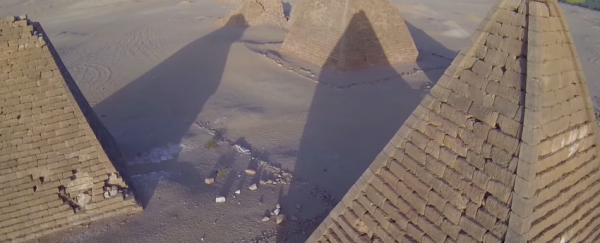Everyone's heard of the great pyramids of Egypt, but thousands of kilometres further south along the Nile stands another impressive group of ancient structures, which have survived in the Sudanese desert for the past 3,000 years. And thanks to this new drone footage captured by National Geographic, we're finally able to get some insight into the sheer scale of these incredible and little-studied pyramids.
Built by the ancient Nubian civilisation, there are around 255 of these beautiful pyramids in three known sites dotted across the Sudanese desert, but most tourists have never heard of them and, so far, very little research has been done into the structures. National Geographic filmed this video as part of a new documentary following one of the first archaeological investigations at the El-Kurru pyramid site in almost 100 years.
El-Kurri was one of the royal cemeteries built for the Nubian royal family during the time of the ancient Kingdom of Kush, and it contains structures that date back to 1070 BC. Just like the Egyptians, the Kushites entombed their royalty below lofty pyramids - presumably to help their souls reach up to the heavens - but structurally, the buildings are quite different. For starters, the Nubian pyramids are far steeper and narrower, and they're built from stepped stones, as opposed to the smooth surfaces of the wider Egyptian pyramids. They're also smaller, ranging from around six to 30 metres in height, compared with the 139 metre Great Pyramid at Giza.
The Nubian pyramids also came around 500 years after the Egyptians had stopped building pyramids of their own. But there's still a lot to learn about the ancient structures - including exactly how and why they were built, and insight into the downfall of the Kushite kingdom around 300 AD. It's hoped that observing the site from the air will help to provide some perspective.
"The best part with the helicopter is I can fly over and gain this connection between all the other burial sites, between the pyramid and the temple, and get an understanding of what that is from the air," National Geographic Society engineer and drone pilot, Alan Turchik, explains in the video above.
Drones aren't the only machines helping to reveal more information about the site - the archaeologist leading the expedition, Geoff Emberling, is also using a remote-controlled robot to excavate caves that are impossible for humans to access. A similar device has helped scientists to photograph never-before-seen secret chambers in Egypt's Great Pyramid at Giza.
We're looking forward to seeing what the team unearths on the ground, but in the meantime, we'll enjoy watching these 3,000-year-old pyramids from the sky.
